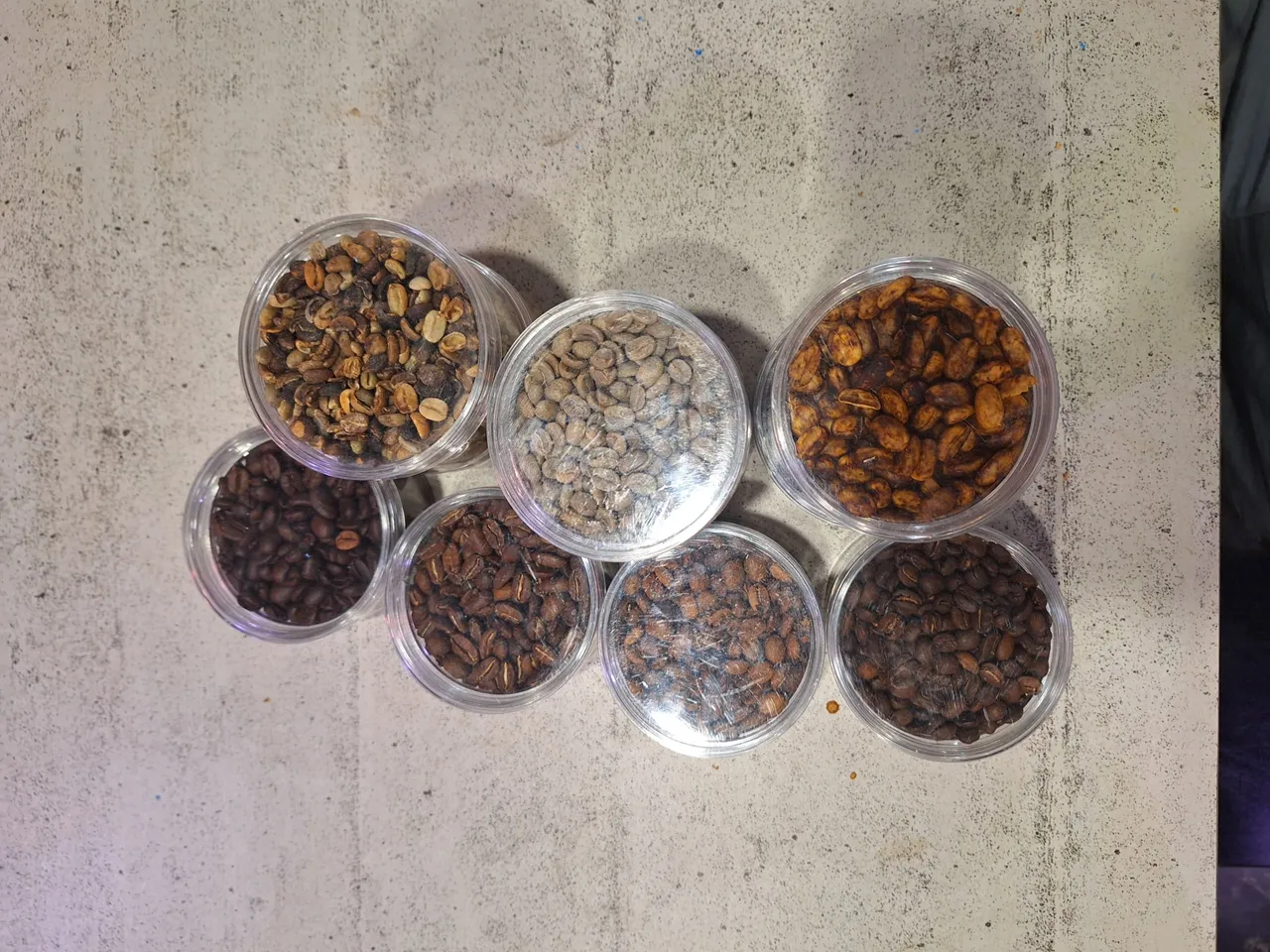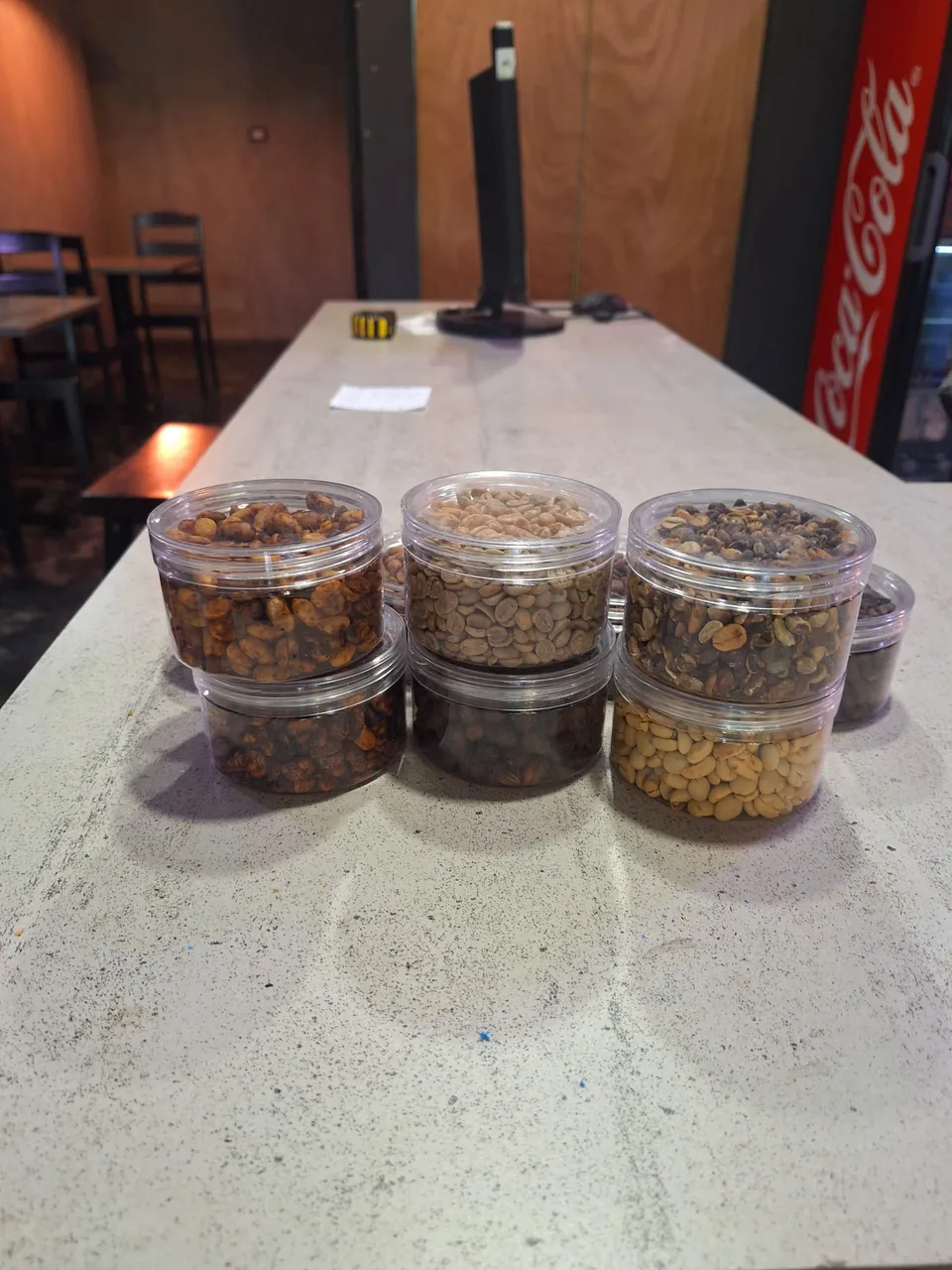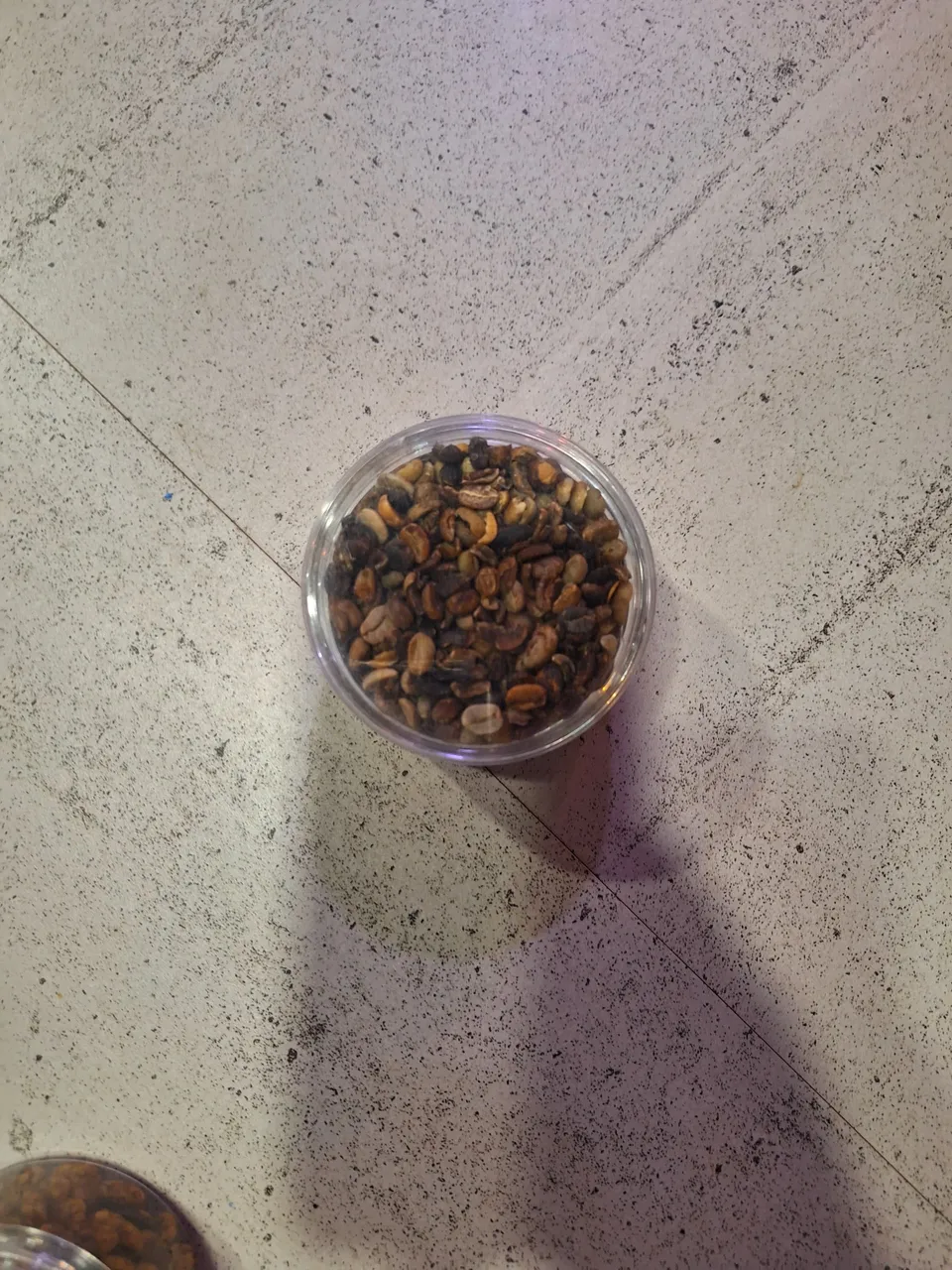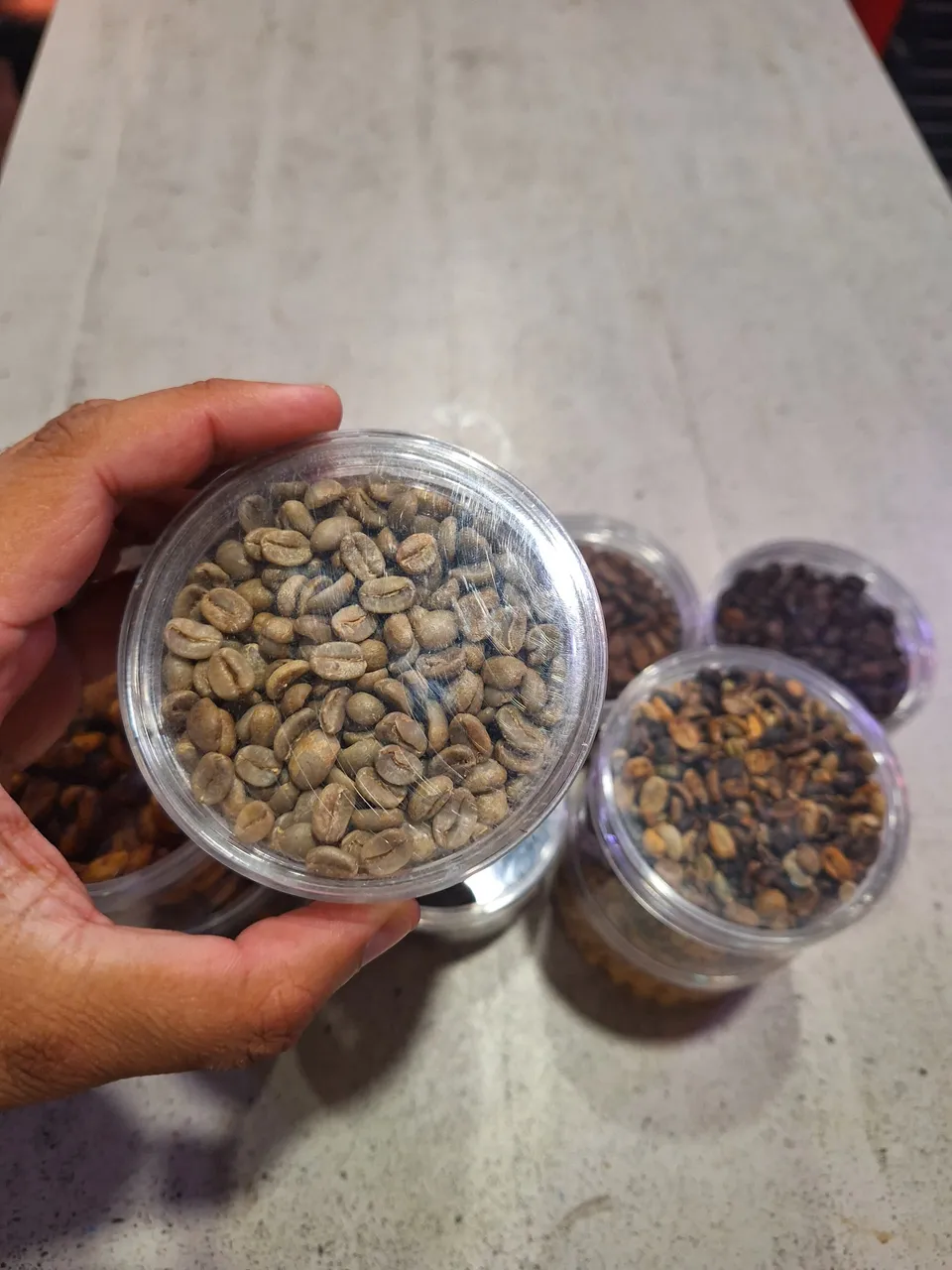
This week, I had the opportunity to learn a little about the coffee roasting process. Between my curiosity and each of the anecdotes, what caught my attention the most was each of the containers that had beans in them, from the moment the fruit was harvested from the coffee tree to the roasting stage. There are several ways of roasting, and each one is a peculiar stage.
I'm one of those people who usually savors the taste of a good cup of coffee. Whenever I go to a coffee shop, I always like to order a cup of latte or the house specialty. Something really peculiar is that the origins of most of my family are linked to the countryside and agricultural production. My maternal grandmother is from one of the oldest cities in Venezuela, The Tocuyo. My father is from Trujillo, and my stepfather is from the state of Yaracuy. All these places have, in one way or another, ties to coffee.

At the same time, for me, each experience is full of new knowledge. Seeing each of these containers with different types of beans on the stages of coffee, I perceived how the process takes place to enjoy the drink that relaxes me so much. It reminded me that there is a great effort and work done by people who love this activity. Therefore, we should value it. The value of every human being is represented by what we can do for others.
The first phase of the coffee-making process begins with the drying of the fruit. In one of the containers, you could see how little by little the fruit was drying. It wasn't the one that stood out the most, but it was there.

The guy in the shop took all the containers, placed them in a line, and explained each stage to me. At that moment, I was amazed, it was something I didn't know about, and I was pleased to have new knowledge on this subject.
There was one container that caught my attention because he separated it from all the others and told me that it was the waste from the whole process. That is, the parts of the coffee that were not good. Everything to be of quality has to purify that which can make it of bad quality.

The second part is the browning part, of course, after the coffee seed has dried. The seed must be allowed to darken little by little. What comes after this part is caramelization.
Caramelization of the coffee seed is one of the most beautiful stages. The seed looks shiny and has a unique color. It is an effect that is obviously generated by roasting.
 |  |
 |  |
 |  |
 |  |
This is the first crack that determines the quality of the coffee, according to what I was told. The processing of the coffee depends on this moment of detachment of the coffee bean. After that, the coffee starts to darken again until the second crack is made to find the dark color of the coffee.

I have come to the most attractive point, and that is the color that coffee usually takes. There can be a light and medium-light roast, but with an underdevelopment or something like that, i.e., it is not fully roasted. There is also a medium roast, a medium and light roast, a dark and light roast, and a dark roast that describe the roasting process as fully developed. Is that interesting? For me, it was when I received the explanation.
The logical point in all this is that the coffee is a medium. In this case, one that can be ingested and marketed. The question here involves the process and how quality coffee can be made.

The brand of this coffee is IMPETU and it has its own touch. I would have liked the packaging to have a label and to be able to better appreciate each of the stages with a brief description, but I got carried away by the explanation I was given. What I remember is what I have written down; if I omitted anything, it is because I may have forgotten it.

The best thing about coffee is being able to appreciate it in its different forms, expressions and characteristics. That's what makes it interesting, and I like it very much.
Original content by @neruel. All rights reserved ©, 2024. Image: Samsung Galaxy A54. Translation: DeepL.
SPANISH VERSION (click here!)
Ésta semana tuve la oportunidad de conocer un poco del proceso de tostado del café. Entre la curiosidad y cada una de las anécdotas, lo que más me llamó la atención fue cada uno de los envases que tenían granos, ya sea desde el momento en que se recolecta la fruta del árbol de café hasta la fase de tostado. Hay varias formas de tostado y cada una es una etapa peculiar.
Yo soy de las personas que suelen degustar el sabor de una buena taza de café. Siempre que voy a una cafetería me gusta pedir una taza de café Latte o la especialidad de la casa. Algo realmente peculiar, es que los orígenes de gran parte de mi familia están ligados al campo y la producción agrícola. Mi abuela materna es de una de las ciudades más antiguas de Venezuela, el Tocuyo. Mi padre es de Trujillo, y mi padrastro es del Estado Yaracuy. Todos estos lugares tienen de una manera u otros lazos con el café.
Al mismo tiempo, para mí cada experiencia se encuentra llena de un conocimiento nuevo. Al ver cada uno de estos envases con diferentes tipos de granos sobre las etapas del café, percibí cómo ocurre el proceso para disfrutar la bebida que tanto me relaja. Eso me hizo recordar que existe un gran esfuerzo y un trabajo efectuado por personas que aman esta actividad. Por ende, debemos valorarla. El valor de cada ser humano está representado en lo que nosotros podemos hacer por otros.
La primera fase del proceso para hacer café inicia con la etapa de secado de la fruta. En uno de los envases se veía cómo poco a poco ésta se iba secando, no era la que más resaltaba, pero estaba allí.
El chico de la tienda tomó todos los envases y los colocó en una línea y me explicó cada fase. En ése momento quedé maravillado, era algo que desconocía y me agradó poder tener nuevos conocimientos sobre éste tema.
Hubo un envase que me llamó la atención porqué lo separó de todos los demás y me acotó que era el de los desperdicios de todo el proceso. Es decir, las partes del café que no eran buenas. Todo para ser de calidad debe depurar aquello que puede hacer que sea de mala calidad.
La segunda parte es la de oscurecimiento, evidentemente, luego de que la semilla de café se ha secado. La semilla debe poco a poco dejarse oscurecer. Lo que viene después de esta parte es la caramelización.
La caramelización de la semilla de café es una de las etapas más hermosas. La semilla se ve brillante y con un color único. Es un efecto que se genera evidentemente por el tostado.
Así llega el primer crack que permite determinar la calidad del café, esto según lo que me acotaron. De este momento de desprendimiento de la semilla de café depende su procesamiento. Luego de ello, el café empieza nuevamente a oscurecer hasta que se efectúa el segundo crack para encontrar un color oscuro del café.
He llegado al punto más atractivo y es el color que suele tomar el café. Puede haber un tostado claro y medio claro, pero con un subdesarrollo o algo así; es decir, que no está plenamente tostado. Hay también un tostado medio, uno medio y claro, otro oscuro y claro, y el oscuro que describen el proceso de tostado como plenamente desarrollado. ¿Es interesante? Para mí lo fue al recibir la explicación.
El punto lógico en todo esto es que el café sea un medio. En éste caso, uno que se pueda ingerir y comercializar. La cuestión acá implica en el proceso y cómo se puede efectuar el café de calidad.
La marca de éste café es IMPETU y tiene su propio toque. Me hubiera gustado que los envases tuvieran una etiqueta y poder apreciar de mejor manera cada una de las fases con una breve descripción, pero me dejé llevar por la explicación que me dieron. Lo que recuerdo es lo que he escrito; si omití algo, es porque lo puedo haber olvidado.
Lo mejor del café es poder apreciarlo en sus diferentes formas, expresiones y características. Es lo que provoca que sea interesante y me agrada fuertemente.
Contenido original de @neruel. Todos los derechos reservados ©, 2024. Imagen: Samsung Galaxy A54. Traducción: DeepL.